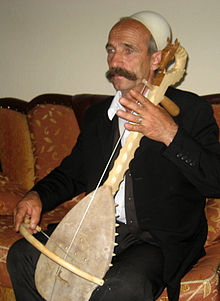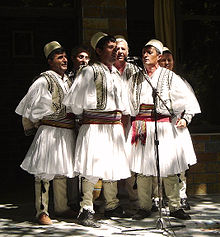Albanian music
The Albanian music ( Albanian muzika shqiptare ) differs very diverse and from region to region. The Albanian musical culture is widespread in the settlement area of the Albanian people in Southeast Europe (or on the Balkan Peninsula ) and includes Albania , most of Kosovo , many areas of North Macedonia and individual strips of land in Serbia , Montenegro and Greece . The old Albanian emigrant communities in Italy (called Arbëresh ), in southern Greece ( Arvanites ) and in other countries in south-east Europe such as Bulgaria , Turkey , Romania and the Ukraine , however, have very independent musical cultures .
Albanian music has changed over the course of history. She took on foreign influences and assimilated them. Turkish music was particularly influential at the time of the Ottoman Empire . The folk music still plays a very important role and plays a very important role, especially in cultural events and family ceremonies. Modern music is also strongly characterized by folklore .
Folk music ensembles from Albanian areas perform at the national folklore festival in Gjirokastra , southern Albania , every five years. This festival is the largest of its kind.
Folk music ( muzika popullore )
Wedding celebrations , sometimes engagements , circumcision celebrations and most family celebrations today are largely accompanied by traditional folk music. They sing old folk songs that are accompanied by music and various dances .
Regional characteristics
The Albanian folk music can be in the first frame in two areas share, which is based on the distribution areas of the two main dialects of the Albanian language, north of the Gheg dialect and southern Tosk area. These two zones are separated by the Shkumbin River in central Albania. In most of the Gegische dances one likes to meet small flutes (alb. Fyell ) and large drums ( lodër ), while with the Tosken clarinet, violin, accordion and frame or bell drum ( def ) predominate. Another characteristic difference is the form of the song. While Gegen are focused on singing in unison (often as a soloist, but also as a duo), Tuscan songs are sung with several voices ( iso-polyphony ).
Musical instruments
Lahuta

“A Lahutë and a Çifteli belong to the house, because the guest does not come to eat, but to tell stories and to enjoy making music. And the mountains are not used to the silence either, they need the heroic songs and the voice of the Lahutë so that they know that their sons live and have not died, just as the heroes do not die either. "
The Lahuta (Alb. Indefinite lahutë ) is a single-stringed fiddle related to the Gusle . The typical northern Albanian musical instrument is also widespread in the mountainous countries of Central Albania. The Lahuta is made by the player ( called Rhapsode ) from a single block of wood, using different types of wood, such as maple, spruce, more rarely poplar, willow, walnut, oak as well as moor alder or wild pumpkin. The sound cover is made of kid goat or rabbit skin. The head is often decorated with a heart, leaf or capricorn figure. The ibex is a symbol for the helmet of Skanderbeg , the Albanian national hero. The bow is made of the wood of the Cornelian cherry, strongly curved and stretched with black horsehair. The Lahuta is usually only played by men, on winter evenings by the fireplace. The host usually starts the song and hands the Lahuta over to the guests in order to respect them in this way. The instrument is seen as that of the mountain dwellers, not that of the peasants.
Çiftelia and Sharki
The two-stringed long-necked lute Çiftelia and Sharki may not have come to Albania until the Ottomans invaded Albania in the 15th century. They are also typical Gegic musical instruments. In contrast to the Lahuta, the singing is done in twos or threes. Two-part singing is rarer, however, and is only practiced in Eastern Albania and among Albanians in Northern Macedonia . In recent years women have increasingly played the Çiftelia, while the Sharki has so far remained in male hands. The sound box of the smaller Çiftelia is made from the wood of the mulberry tree, while the top is made from that of the fir, spruce or pine tree. The Sharki has the same design as the Çiftelia, but is larger and offers a larger range. Roughly the same materials are used in the production. The size of the instrument makes the Sharki sound deeper and warmer than the Çifteli.
Fyell

The musicians build their flutes (alb. Fyell ) out of wood, metal or plastic. Mostly the flutists play improvised pieces. The Fyell can also be found in the majority in the Gegen. It was a typical musical instrument used by the shepherds.
Surle
The surle is a double-reed instrument with a bell similar to the Turkish zurna , which is played in Gegish music. The wood material must not have any knots during manufacture. Olives, cherry or nut wood are common. There are seven finger holes and a thumb hole on the bottom.
Roga or Gajde
The roga (Tuscan name: Gajde) is a type of bagpipe native to northern Albania that has 11 tones.
Def or Dajre
The Def , a frame drum with a bell ring , is common at both Gegen and Tosken. In the north it is called Dajre . It is one of the few musical instruments that women also play. Some folk songs are only accompanied by the def. For example, an important part of the music for the "two-part dances" is the Tosken. This dance, which is widespread in the region of the Myzeqe plain, needs the Dajre for its rhythm. The Dajre has such a key role with the Çamen of southern Albania and north-western Greece . This dance called Valle Çame is known as Tsamikos in Greece .
Lodra

The cylinder drum Lodra (Alb. Indefinitely lodër ) is similar to the Turkish Davul . The meaning of the word comes from the verb “lodroj”, which means “I dance”. This illustrates the enormous importance of the Lodra for various dances. The bass drum is more common in Gegen. During the Muslim fasting month of Ramadan , drummers remember the last meal before sunrise in the early morning.
The wooden cylinder is covered with animal fur on both sides (donkey, goat or sheep are the usual ones). The cracking sound of the Lodër is often associated with the crack of a gun in poetry in Albania.
singing
The most important characteristic difference between the folk music of the northern Albanian counter and that of the southern Albanian Tosks is the type of singing used in folk songs. In the former, the soloist is widespread, while in the latter, iso-polyphony (multiple voices) predominates.
Majekrahi
A special solo form of singing among the Gegen is the "Majekrahi". A special position is assumed: the ear is closed with one or more fingers and the tip of the elbow is more or less directed upwards. The word "Majekrahi" has its origin from this attitude. "Majekrahi" means "arm tip". This form of singing was used to convey messages in the mountains in the past when there were no means of communication. Such songs are sung only in northern Albania, parts of Montenegro and Kosovo. Today this form of singing has therefore been forgotten and is threatened with disappearing.
Iso-polyphony
Although the traditional polyphonic singing, the iso-polyphony , is mainly found in southern Albania and northwestern Greece, Gegian women also make use of it, but with their own forms. In the polyphonic music of Albania, roughly three groups are distinguished. The largest is that of the Tosks, who settle in the area between the Shkumbin and Vjosa rivers . The second include the Laben , which are native to the south of the Vjosa as far as Saranda . The regions south of Saranda and those of the Çamen in northwestern Greece (alb. Çamëria , the region Thesprotia ) belong to the third group. The polyphonic singing is accompanied by a drone voice , which requires repeating or holding out a note. Tosken and Çamen sing this tone on the vowel E, while the lobes vary between E and O. The singing style has been under the protection of UNESCO since 2005 as a masterpiece of the oral and intangible heritage of humanity .
literature
- Spiro J. Shetuni: Albanian Traditional Music: An Introduction, with Sheet Music and Lyrics for 48 Songs . McFarland, 2011, ISBN 0-7864-8630-9 .
Web links
- Official website of Iso-Polyphonie Albania (Albanian)
- Soundscape Shqiperia - a sound journey through Albania
Individual evidence
- ↑ Qendra Kombëtare e Veprimtarive Folklorike. Retrieved March 29, 2018 (Albanian).
- ↑ Johannes Scherzer, Johannes Varga: Cultural landscapes. In: Soundscape Shqiperia - sound journey through Albania. University of Film and Television "Konrad Wolf" ( Babelsberg ), accessed on August 3, 2012 .
- ↑ Ardian Ahmedaja, Ursula Reinhard: “Your heart should always sing! - Insights into the folk music traditions of Albania ” . Institute for Folk Music Research and Ethnomusicology, Vienna 2003.
- ↑ Johannes Scherzer, Johannes Varga: The Lahutë. In: Soundscape Shqiperia - sound journey through Albania. University of Film and Television "Konrad Wolf" ( Babelsberg ), accessed on August 3, 2012 .
- ↑ Johannes Scherzer, Johannes Varga: Çifteli and Sharki. In: Soundscape Shqiperia - sound journey through Albania. University of Film and Television "Konrad Wolf" ( Babelsberg ), accessed on August 3, 2012 .
- ↑ Johannes Scherzer, Johannes Varga: Fyell. In: Soundscape Shqiperia - sound journey through Albania. University of Film and Television "Konrad Wolf" ( Babelsberg ), accessed on August 3, 2012 .
- ↑ Johannes Scherzer, Johannes Varga: Surle. In: Soundscape Shqiperia - sound journey through Albania. University of Film and Television "Konrad Wolf" ( Babelsberg ), accessed on December 9, 2015 .
- ↑ Johannes Scherzer, Johannes Varga: Roga or Gajde. In: Soundscape Shqiperia - sound journey through Albania. University of Film and Television "Konrad Wolf" ( Babelsberg ), accessed on August 3, 2012 .
- ↑ Johannes Scherzer, Johannes Varga: Def. In: Soundscape Shqiperia - sound journey through Albania. University of Film and Television "Konrad Wolf" ( Babelsberg ), accessed on August 3, 2012 .
- ↑ Johannes Scherzer, Johannes Varga: Lodër. In: Soundscape Shqiperia - sound journey through Albania. University of Film and Television "Konrad Wolf" ( Babelsberg ), accessed on August 3, 2012 .
- ↑ a b Johannes Scherzer, Johannes Varga: Majekrahi and Iso-Polyphonie. In: Soundscape Shqiperia - sound journey through Albania. University of Film and Television "Konrad Wolf" ( Babelsberg ), accessed on August 3, 2012 .
- ^ Albanian Folk Iso-Polyphony. In: UNESCO . Retrieved August 3, 2012 .
